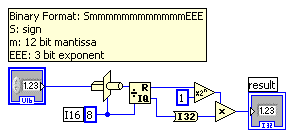- Subscribe to RSS Feed
- Mark Topic as New
- Mark Topic as Read
- Float this Topic for Current User
- Bookmark
- Subscribe
- Mute
- Printer Friendly Page
How do I convert 16 bit Binary to ASCII text
06-21-2006 10:54 AM
- Mark as New
- Bookmark
- Subscribe
- Mute
- Subscribe to RSS Feed
- Permalink
- Report to a Moderator
Hmm, so what needs to be done???
So far we know how the data is represented. What kind of input do you have and what kind of output do you want?
(Better just give us an example VI with typical data as default in a control of the desired type and a description on how the output should look like).
06-21-2006 11:56 AM
- Mark as New
- Bookmark
- Subscribe
- Mute
- Subscribe to RSS Feed
- Permalink
- Report to a Moderator
Output is a +/- DBL value.
Input are two hex decimal words.
The two words need to be converted to binary (10010......) and concatenated to form a 32 bit binary number. If the first bit is a one, the bits must be flipped add a one etc. prior to performing the 2's complmentary math to arrive at a number that is then negated. If the first bit is zero, easy, just use the remaining 15 bits to perform the 2's comp math. Hope this helps
Thanks
06-21-2006 12:05 PM
- Mark as New
- Bookmark
- Subscribe
- Mute
- Subscribe to RSS Feed
- Permalink
- Report to a Moderator
06-21-2006 12:12 PM
- Mark as New
- Bookmark
- Subscribe
- Mute
- Subscribe to RSS Feed
- Permalink
- Report to a Moderator
I don't know?
What would your solution be for
word 1 = 624
word 2 = 2448
Max/Min Value +/- 1.0240E+03
resolution 3.8147E-06
MSB = 2^12
LSB = 2^-18
Full scale of the data 8.1920E+03
06-21-2006 03:50 PM - edited 06-21-2006 03:50 PM
- Mark as New
- Bookmark
- Subscribe
- Mute
- Subscribe to RSS Feed
- Permalink
- Report to a Moderator
Message Edited by altenbach on 06-21-2006 02:02 PM
06-21-2006 04:07 PM
- Mark as New
- Bookmark
- Subscribe
- Mute
- Subscribe to RSS Feed
- Permalink
- Report to a Moderator
06-22-2006 12:10 PM
- Mark as New
- Bookmark
- Subscribe
- Mute
- Subscribe to RSS Feed
- Permalink
- Report to a Moderator
altenbach,
You VI is simple and works with negative numbers. More importantly, your VI provides verification for my VI.
Thank you
Where can I send your 2 - JDAM product patches?
06-22-2006 12:23 PM
- Mark as New
- Bookmark
- Subscribe
- Mute
- Subscribe to RSS Feed
- Permalink
- Report to a Moderator
06-22-2006 03:42 PM
- Mark as New
- Bookmark
- Subscribe
- Mute
- Subscribe to RSS Feed
- Permalink
- Report to a Moderator
Altenbach - You are five stars in my book.
I came accross a new problem that I was wondering if you could assist to simplify?
Same type data 16 bit word
Field name Bit No Description
Integer -00- S Sign Bit
-01- N MSB
-02- ..... -10- N
-11- N LSB
Exponent -12- E MSB
-13-....-14-
-15- E LSB
Integer Resolution 1 MSB 2^10 LSB 2^0
Exponent Resolution 1 MSB 2^3 LSB 2^0
Is there a simple way of handling this problem?
06-22-2006 05:51 PM - edited 06-22-2006 05:51 PM
- Mark as New
- Bookmark
- Subscribe
- Mute
- Subscribe to RSS Feed
- Permalink
- Report to a Moderator

Message Edited by altenbach on 06-22-2006 03:52 PM
